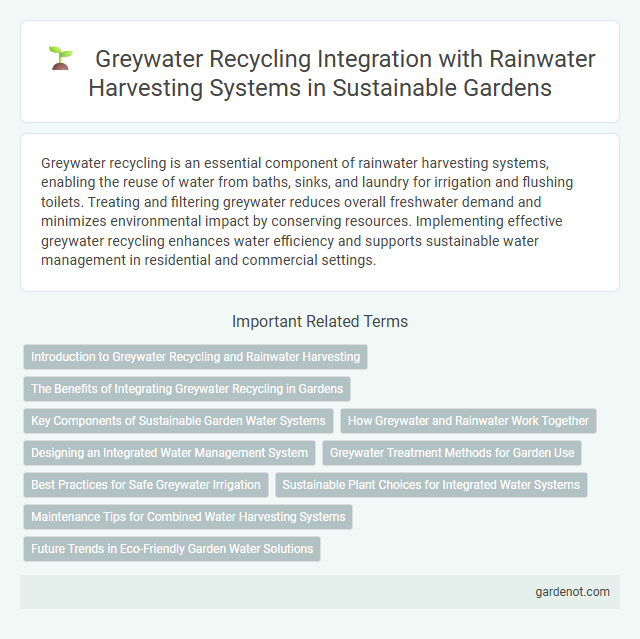Greywater recycling is an essential component of rainwater harvesting systems, enabling the reuse of water from baths, sinks, and laundry for irrigation and flushing toilets. Treating and filtering greywater reduces overall freshwater demand and minimizes environmental impact by conserving resources. Implementing effective greywater recycling enhances water efficiency and supports sustainable water management in residential and commercial settings.
Introduction to Greywater Recycling and Rainwater Harvesting
Greywater recycling involves collecting and treating water from domestic sources such as sinks, showers, and laundry to reduce freshwater consumption and enhance sustainability. When integrated with rainwater harvesting systems, greywater recycling maximizes water reuse potential by providing non-potable water for irrigation, toilet flushing, and landscaping applications. This combined approach significantly decreases urban water demand and contributes to improved water management in residential and commercial settings.
The Benefits of Integrating Greywater Recycling in Gardens
Integrating greywater recycling in gardens significantly reduces freshwater consumption by reusing bath, sink, and laundry water for irrigation, promoting sustainable water management. This practice enhances soil moisture retention and supports plant health by supplying nutrient-rich water, which decreases the need for chemical fertilizers. Greywater recycling also lowers household water bills and minimizes strain on municipal wastewater treatment systems, contributing to overall environmental conservation.
Key Components of Sustainable Garden Water Systems
Key components of sustainable garden water systems include greywater recycling technologies such as specialized filtration units, storage tanks, and distribution networks designed to safely capture and reuse household wastewater from sinks, showers, and laundry. Incorporating biofiltration gardens and subsurface irrigation methods enhances water efficiency by minimizing runoff and promoting groundwater recharge. Advanced sensors and automated valves optimize system performance, reducing water waste and supporting eco-friendly landscape management.
How Greywater and Rainwater Work Together
Greywater recycling and rainwater harvesting complement each other by providing sustainable water sources for non-potable uses like irrigation and toilet flushing, reducing reliance on municipal water. Greywater, which comes from showers and sinks, can be treated and combined with harvested rainwater to maximize water efficiency and decrease overall water consumption. Integrating these systems supports water conservation efforts by ensuring continuous availability of recycled and collected water throughout varying weather conditions.
Designing an Integrated Water Management System
Designing an integrated water management system for rainwater harvesting includes incorporating greywater recycling to maximize water efficiency in residential and commercial buildings. This system captures, treats, and reuses greywater from sinks, showers, and laundry for non-potable applications such as irrigation and toilet flushing, reducing freshwater demand significantly. Advanced filtration, microbial treatment units, and smart sensors optimize water quality and automate distribution, ensuring sustainable water conservation and compliance with local regulations.
Greywater Treatment Methods for Garden Use
Greywater treatment methods for garden use commonly include filtration, sedimentation, and biological treatment processes like constructed wetlands and biofilters to remove contaminants and pathogens. Filtration systems use sand, gravel, or fabric filters to physically separate particles, while sedimentation allows solids to settle before further treatment. Biological treatments leverage natural microbial activity to degrade organic matter, ensuring treated greywater is safe and nutrient-rich for irrigation.
Best Practices for Safe Greywater Irrigation
Safe greywater irrigation requires proper filtration and disinfection to prevent pathogen exposure and soil contamination. Selecting appropriate irrigation methods, such as subsurface or drip irrigation, minimizes human contact and reduces evaporation losses. Regular system maintenance and use of biodegradable, low-sodium detergents ensure long-term sustainability and protect plant health.
Sustainable Plant Choices for Integrated Water Systems
Greywater recycling enhances rainwater harvesting by reducing freshwater demand through sustainable plant choices like drought-tolerant species and native plants adapted to local climates. These plants require minimal irrigation, efficiently utilize recycled greywater, and support soil health, promoting a resilient integrated water system. Incorporating deep-rooted vegetation further optimizes water absorption and nutrient cycling, improving overall system sustainability.
Maintenance Tips for Combined Water Harvesting Systems
Regular inspection and cleaning of filters and storage tanks are crucial to prevent clogs and contamination in greywater recycling within combined rainwater harvesting systems. Maintaining pump functionality and monitoring water quality ensures efficient system performance and safe reuse for irrigation or non-potable applications. Seasonal checks and prompt repairs of pipes and valves extend system lifespan and optimize resource conservation.
Future Trends in Eco-Friendly Garden Water Solutions
Greywater recycling is set to revolutionize eco-friendly garden water solutions by integrating smart filtration systems that enhance water purity while minimizing waste. Emerging technologies leverage AI-driven sensors to optimize greywater reuse for irrigation, significantly reducing freshwater consumption in urban landscaping. Future trends indicate widespread adoption of automated greywater systems, promoting sustainable water management and supporting resilient green infrastructures.
Greywater recycling Infographic

 gardenot.com
gardenot.com